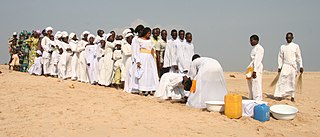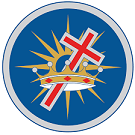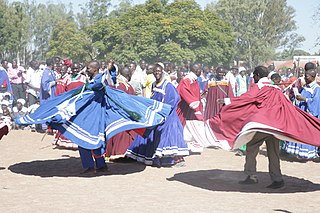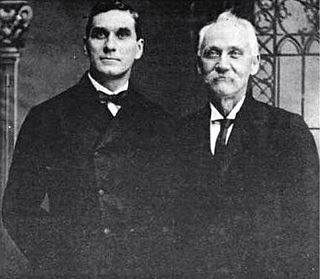
John Alexander Dowie was a Scottish-Australian minister known as an evangelist and faith healer. He began his career as a minister of religion in South Australia. After becoming an evangelist and faith healer, he emigrated with his family to the United States in 1888, first settling in San Francisco, where he developed his faith healing practise into a mail order business. He moved to Chicago in time to take advantage of the crowds attracted to the 1893 World's Fair. After attracting a huge faith healing business in Chicago, with multiple homes and businesses, including a publishing house, to keep his thousands of followers, he bought an extensive parcel of land north of the city to set up a private community.
Christ Community Church in Zion, Illinois, formerly the Christian Catholic Church or Christian Catholic Apostolic Church, is an evangelical non-denominational church founded in 1896 by John Alexander Dowie. The city of Zion was founded by Dowie as a religious community to establish a society on the principles of the Kingdom of God. Members are sometimes called Zionites.
The Ethiopian movement is a religious movement that began in southern Africa towards the end of the 19th and early 20th century, when two groups broke away from the Anglican and Methodist churches. One of the main reasons for breaking away was the growing idea that Africa had little to no history before the European colonisation of the continent, leaving many Africans upset at the prospect of their heritage and culture being erased through colonialism.
Zionism is the movement that supports the creation of a Jewish homeland.

An African-initiated church (AIC) is a Christian church independently started in Africa by Africans rather than chiefly by missionaries from another continent.

The Zion Christian Church (ZCC) is one of the largest African-initiated churches operating across Southern Africa, and is part of the African Zionism movement. The church's headquarters are at Zion City Moria in Limpopo Province, South Africa.

John Graham Lake was a Canadian-American leader in the Pentecostal movement that began in the early 20th century, and is known as a faith healer, missionary, and with Thomas Hezmalhalch, co-founder of the Apostolic Faith Mission of South Africa. Through his 1908–19 African missionary work, Lake played a decisive role in the spread of Pentecostalism in South Africa, the most successful southern African religious movement of the 20th century. After completing his missionary work in Africa, Lake evangelized for 10 years, primarily along the west coast of the United States setting up "healing rooms" and healing campaigns, and establishing churches. Lake was influenced by the healing ministry of John Alexander Dowie and the ministry of Charles Parham.

The Apostolic Faith Mission of South Africa (AFM) is a classical Pentecostal Christian denomination in South Africa. With 1.2 million adherents, it is South Africa's largest Pentecostal church and the fifth largest religious grouping in South Africa representing 7.6 percent of the population. Dr. Isak Burger has led the AFM as president since 1996 when the white and black branches of the church were united. It is a member of the Apostolic Faith Mission International, a fellowship of 23 AFM national churches. It is also a member of the South African Council of Churches.

Isaiah Mloyiswa Mdliwamafa Shembe, was a prophet and the founder of the Ibandla lamaNazaretha, South Africa, which was the largest African-initiated church in Africa during his lifetime. Shembe started his religious career as an itinerant evangelist and faith healer in 1910. Within ten years, he had built up a large following in Natal with dozens of congregations across the province. To date, there is a rapid emergence of organized congregations and seminary events across the nine provinces of South Africa.

African Zionism is a religious movement with 15–18 million members throughout Southern Africa, making it the largest religious movement in the region. It is a combination of Christianity and African traditional religion. Zionism is the predominant religion of Eswatini and forty percent of Swazis consider themselves Zionist. It is also common among Zulus in South Africa. The amaZioni are found in South Africa, Eswatini, Mozambique, Malawi, Zimbabwe, Botswana, and Namibia. A large organization within this movement is the Zion Christian Church.
Zion Church may refer to:

Thomas Hezmalhalch, usually known as Tom Hezmalhalch, was an American missionary, who together with John G. Lake founded the Apostolic Faith Mission of South Africa and was its first chairman and president. He was influenced by the healing ministry of John Alexander Dowie.
Pieter Louis Le Roux or PL Le Roux (1865–1943) was a South African missionary, who was a leading figure in the Zion Church movement in South Africa and the Apostolic Faith Mission of South Africa. Le Roux was initially a missionary for the Dutch Reformed Church. He was heavily influenced by the healing ministry of John Alexander Dowie and his Zionist movement which he later joined. Later he joined the Pentecostal movement of John G. Lake and Thomas Hezmalhalch. He was president of the Apostolic Faith Mission of South Africa from 1913 to 1942. His involvement with black leaders in South Africa led to the establishment of a conglomerate of churches from both Zionist and Pentecostal backgrounds, most notably the Zion Christian Church (ZCC).

Engenas Barnabas Lekganyane was the founder of the Zion Christian Church (ZCC). He first formed the ZCC in 1924, and by the time of his death the church had at least 50,000 members. Under the leadership of his descendants the ZCC has gone on to have more than a million members primarily located in southern Africa. It is now by far the biggest of the various Zionist Christian sects that account for roughly half of all Christians in southern Africa.
Bishop Samuel Mutendi (c.1880-1976) was the founder of the Zimbabwean based Zion Christian Church (Z.C.C), which under his leadership grew to a membership of more than 250,000, and is believed to have grown three or four times larger today and one of the largest religious organizations in the country. As the religious leader responsible for the popularization of Zionist Christianity into Zimbabwe, he is arguably the most influential religious personality in the country's history.

Pentecostalism in Australia is a large and growing Christian movement. Pentecostalism is a renewal movement within Protestant Christianity that places special emphasis on a direct personal experience of God through baptism with the Holy Spirit. It emerged from 19th century precursors between 1870 and 1910, taking denominational form from c. 1927. From the early 1930s, Pentecostal denominations multiplied, and there are now several dozen, the largest of which relate to one another through conferences and organisations such as the Australian Pentecostal Ministers Fellowship. The Australian Christian Churches, formerly known as the Australian Assemblies of God, is the oldest and longest lasting Pentecostal organisation in Australia. The AOG/ACC is also the largest Pentecostal organisation in Australia with over 300,000 members in 2018. Until 2018, Hillsong Church was one of 10 megachurches in Australia associated with the ACC that have at least 2,000 members weekly. According to the church, over 100,000 people attend services each week at the church or one of its 80 affiliated churches located worldwide.
Pentecostalism began spreading in South Africa after William J. Seymour, of the Azusa Street mission, sent missionaries to convert and organize missions. By the 1990s, approximately 10% of the population of South Africa was Pentecostal. The largest denominations were the Apostolic Faith Mission, Assemblies of God, and the Full Gospel Church of God. Another 30% of the population was made up of mostly black Zionist and Apostolic churches, which comprise a majority of South Africa's African Instituted Churches(AICs). In a 2006 survey, 1 in 10 urban South Africans said they were Pentecostal, and 2 in 10 said they were charismatic. In total, renewalists comprised one-fourth of the South African urban population. A third of all protestants surveyed said that they were Pentecostal or charismatic, and one-third of all South African AIC members said they were charismatic.
The Zion Apostolic Faith Mission Church is one of the earliest Zionist sects in southern Africa. It was formed out of a secession from the Pentecostal Apostolic Faith Mission in 1919, and attempted to create southern Africa's second "Zion City" in emulation of John Alexander Dowie. Although ZAFM was initially an influential church in Zionist circles, it failed to develop and prosper over the decades. It is best known today for spawning two secessions of its own that grew into large churches—the Zion Christian Church and the Zimbabwean Zion Apostolic Faith Mission.
Edward Lekganyane, popularly known as "Kgoshi Edward", was the leader of the Zion Christian Church (ZCC) from Easter Sunday, April 17, 1949, until his death eighteen years later. During this time he used his charisma and organizational abilities to expand the ZCC from about 50,000 to 600,000 members, while also reshaping numerous facets of the church. During his tenure as bishop, the ZCC emerged as South Africa's largest independent church, while Lekganyane became arguably the wealthiest and most powerful African in apartheid-era South Africa.
Sarah Jane Lancaster was the leader of Australia's first Pentecostal congregation. An evangelist and administrator, she established a printing press in her meeting hall to produce evangelistic tracts and pamphlets. Lancaster also published Australia's first Pentecostal magazine, Good News. Lancaster became president of the nation's earliest attempt to organise Pentecostalism into a denomination, the Apostolic Faith Mission of Australasia. Although she is recognised as the founder of Australian Pentecostalism and contributed to the unique prominence of women in the founding of Australian Pentecostal congregations, many of her doctrinal ideas were quickly abandoned as the movement developed.










